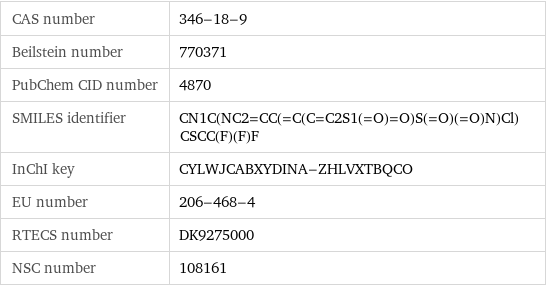Input interpretation

polythiazide
Chemical names and formulas

formula | C_11H_13ClF_3N_3O_4S_3 Hill formula | C_11ClF_3H_13N_3O_4S_3 name | polythiazide IUPAC name | 6-chloro-2-methyl-1, 1-dioxo-3-(2, 2, 2-trifluoroethylsulfanylmethyl)-3, 4-dihydro-1$l^{6}, 2, 4-benzothiadiazine-7-sulfonamide alternate names | drenusil | nephril | renese mass fractions | C (carbon) 30% | Cl (chlorine) 8.06% | F (fluorine) 13% | H (hydrogen) 2.98% | N (nitrogen) 9.55% | O (oxygen) 14.5% | S (sulfur) 21.9%
Lewis structure

Draw the Lewis structure of polythiazide. Start by drawing the overall structure of the molecule, ignoring potential double and triple bonds: Count the total valence electrons of the carbon (n_C, val = 4), chlorine (n_Cl, val = 7), fluorine (n_F, val = 7), hydrogen (n_H, val = 1), nitrogen (n_N, val = 5), oxygen (n_O, val = 6), and sulfur (n_S, val = 6) atoms: 11 n_C, val + n_Cl, val + 3 n_F, val + 13 n_H, val + 3 n_N, val + 4 n_O, val + 3 n_S, val = 142 Calculate the number of electrons needed to completely fill the valence shells for carbon (n_C, full = 8), chlorine (n_Cl, full = 8), fluorine (n_F, full = 8), hydrogen (n_H, full = 2), nitrogen (n_N, full = 8), oxygen (n_O, full = 8), and sulfur (n_S, full = 8): 11 n_C, full + n_Cl, full + 3 n_F, full + 13 n_H, full + 3 n_N, full + 4 n_O, full + 3 n_S, full = 226 Subtracting these two numbers shows that 226 - 142 = 84 bonding electrons are needed. Each bond has two electrons, so in addition to the 39 bonds already present in the diagram we expect to add 3 bonds. To minimize formal charge carbon wants 4 bonds and oxygen wants 2 bonds. Identify the atoms that want additional bonds and the number of electrons remaining on each atom: Add 3 bonds by pairing electrons between adjacent highlighted atoms. Additionally, atoms with large electronegativities can minimize their formal charge by forcing atoms with smaller electronegativities on period 3 or higher to expand their valence shells. The electronegativities of the atoms are 2.20 (hydrogen), 2.55 (carbon), 2.58 (sulfur), 3.04 (nitrogen), 3.16 (chlorine), 3.44 (oxygen), and 3.98 (fluorine). Because the electronegativity of sulfur is smaller than the electronegativity of oxygen and the electronegativity of {} is smaller than the electronegativity of {}, expand the valence shell of sulfur to 6 bonds in 2 places and expand the valence shell of {} to {} bonds. Therefore we add a total of 7 bonds to the diagram: Answer: | |
Basic properties

molar mass | 439.9 g/mol phase | solid (at STP) melting point | 202.5 °C solubility in water | insoluble
Units

Hydrophobicity and permeability properties

experimental LogP hydrophobicity | 1.9 predicted LogP hydrophobicity | 2.13 predicted LogS | -3.22
Basic drug properties

approval status | approved | small molecule drug categories | antihypertensive agent | diuretic | sodium chloride symporter inhibitor dosage forms | oral: tablet
Chemical identifiers

CAS number | 346-18-9 Beilstein number | 770371 PubChem CID number | 4870 SMILES identifier | CN1C(NC2=CC(=C(C=C2S1(=O)=O)S(=O)(=O)N)Cl)CSCC(F)(F)F InChI key | CYLWJCABXYDINA-ZHLVXTBQCO EU number | 206-468-4 RTECS number | DK9275000 NSC number | 108161
Toxicity properties

RTECS classes | drug | human data